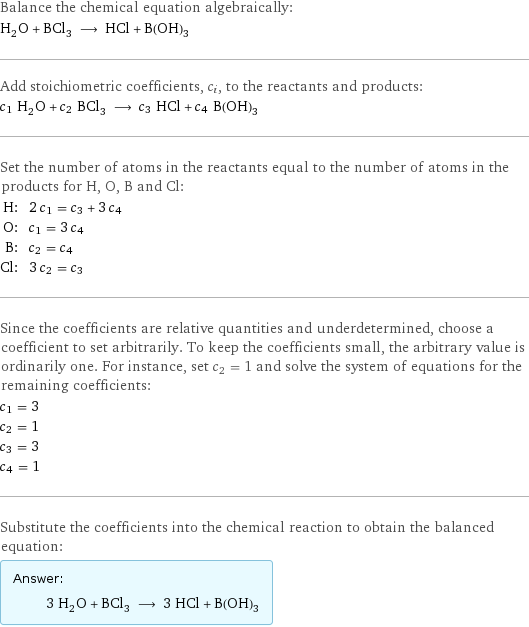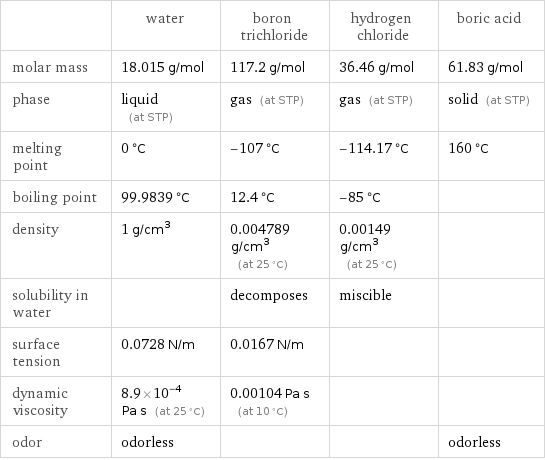Input interpretation

H_2O water + BCl_3 boron trichloride ⟶ HCl hydrogen chloride + B(OH)_3 boric acid
Balanced equation

Balance the chemical equation algebraically: H_2O + BCl_3 ⟶ HCl + B(OH)_3 Add stoichiometric coefficients, c_i, to the reactants and products: c_1 H_2O + c_2 BCl_3 ⟶ c_3 HCl + c_4 B(OH)_3 Set the number of atoms in the reactants equal to the number of atoms in the products for H, O, B and Cl: H: | 2 c_1 = c_3 + 3 c_4 O: | c_1 = 3 c_4 B: | c_2 = c_4 Cl: | 3 c_2 = c_3 Since the coefficients are relative quantities and underdetermined, choose a coefficient to set arbitrarily. To keep the coefficients small, the arbitrary value is ordinarily one. For instance, set c_2 = 1 and solve the system of equations for the remaining coefficients: c_1 = 3 c_2 = 1 c_3 = 3 c_4 = 1 Substitute the coefficients into the chemical reaction to obtain the balanced equation: Answer: | | 3 H_2O + BCl_3 ⟶ 3 HCl + B(OH)_3
Structures

+ ⟶ +
Names

water + boron trichloride ⟶ hydrogen chloride + boric acid
Reaction thermodynamics
Enthalpy

| water | boron trichloride | hydrogen chloride | boric acid molecular enthalpy | -285.8 kJ/mol | -403.8 kJ/mol | -92.3 kJ/mol | -1094 kJ/mol total enthalpy | -857.5 kJ/mol | -403.8 kJ/mol | -276.9 kJ/mol | -1094 kJ/mol | H_initial = -1261 kJ/mol | | H_final = -1371 kJ/mol | ΔH_rxn^0 | -1371 kJ/mol - -1261 kJ/mol = -109.9 kJ/mol (exothermic) | | |
Gibbs free energy

| water | boron trichloride | hydrogen chloride | boric acid molecular free energy | -237.1 kJ/mol | -388.7 kJ/mol | -95.3 kJ/mol | -968.9 kJ/mol total free energy | -711.3 kJ/mol | -388.7 kJ/mol | -285.9 kJ/mol | -968.9 kJ/mol | G_initial = -1100 kJ/mol | | G_final = -1255 kJ/mol | ΔG_rxn^0 | -1255 kJ/mol - -1100 kJ/mol = -154.8 kJ/mol (exergonic) | | |
Equilibrium constant
![Construct the equilibrium constant, K, expression for: H_2O + BCl_3 ⟶ HCl + B(OH)_3 Plan: • Balance the chemical equation. • Determine the stoichiometric numbers. • Assemble the activity expression for each chemical species. • Use the activity expressions to build the equilibrium constant expression. Write the balanced chemical equation: 3 H_2O + BCl_3 ⟶ 3 HCl + B(OH)_3 Assign stoichiometric numbers, ν_i, using the stoichiometric coefficients, c_i, from the balanced chemical equation in the following manner: ν_i = -c_i for reactants and ν_i = c_i for products: chemical species | c_i | ν_i H_2O | 3 | -3 BCl_3 | 1 | -1 HCl | 3 | 3 B(OH)_3 | 1 | 1 Assemble the activity expressions accounting for the state of matter and ν_i: chemical species | c_i | ν_i | activity expression H_2O | 3 | -3 | ([H2O])^(-3) BCl_3 | 1 | -1 | ([BCl3])^(-1) HCl | 3 | 3 | ([HCl])^3 B(OH)_3 | 1 | 1 | [B(OH)3] The equilibrium constant symbol in the concentration basis is: K_c Mulitply the activity expressions to arrive at the K_c expression: Answer: | | K_c = ([H2O])^(-3) ([BCl3])^(-1) ([HCl])^3 [B(OH)3] = (([HCl])^3 [B(OH)3])/(([H2O])^3 [BCl3])](../image_source/36058215ad1cbe62afcbef14ac313aa5.png)
Construct the equilibrium constant, K, expression for: H_2O + BCl_3 ⟶ HCl + B(OH)_3 Plan: • Balance the chemical equation. • Determine the stoichiometric numbers. • Assemble the activity expression for each chemical species. • Use the activity expressions to build the equilibrium constant expression. Write the balanced chemical equation: 3 H_2O + BCl_3 ⟶ 3 HCl + B(OH)_3 Assign stoichiometric numbers, ν_i, using the stoichiometric coefficients, c_i, from the balanced chemical equation in the following manner: ν_i = -c_i for reactants and ν_i = c_i for products: chemical species | c_i | ν_i H_2O | 3 | -3 BCl_3 | 1 | -1 HCl | 3 | 3 B(OH)_3 | 1 | 1 Assemble the activity expressions accounting for the state of matter and ν_i: chemical species | c_i | ν_i | activity expression H_2O | 3 | -3 | ([H2O])^(-3) BCl_3 | 1 | -1 | ([BCl3])^(-1) HCl | 3 | 3 | ([HCl])^3 B(OH)_3 | 1 | 1 | [B(OH)3] The equilibrium constant symbol in the concentration basis is: K_c Mulitply the activity expressions to arrive at the K_c expression: Answer: | | K_c = ([H2O])^(-3) ([BCl3])^(-1) ([HCl])^3 [B(OH)3] = (([HCl])^3 [B(OH)3])/(([H2O])^3 [BCl3])
Rate of reaction
![Construct the rate of reaction expression for: H_2O + BCl_3 ⟶ HCl + B(OH)_3 Plan: • Balance the chemical equation. • Determine the stoichiometric numbers. • Assemble the rate term for each chemical species. • Write the rate of reaction expression. Write the balanced chemical equation: 3 H_2O + BCl_3 ⟶ 3 HCl + B(OH)_3 Assign stoichiometric numbers, ν_i, using the stoichiometric coefficients, c_i, from the balanced chemical equation in the following manner: ν_i = -c_i for reactants and ν_i = c_i for products: chemical species | c_i | ν_i H_2O | 3 | -3 BCl_3 | 1 | -1 HCl | 3 | 3 B(OH)_3 | 1 | 1 The rate term for each chemical species, B_i, is 1/ν_i(Δ[B_i])/(Δt) where [B_i] is the amount concentration and t is time: chemical species | c_i | ν_i | rate term H_2O | 3 | -3 | -1/3 (Δ[H2O])/(Δt) BCl_3 | 1 | -1 | -(Δ[BCl3])/(Δt) HCl | 3 | 3 | 1/3 (Δ[HCl])/(Δt) B(OH)_3 | 1 | 1 | (Δ[B(OH)3])/(Δt) (for infinitesimal rate of change, replace Δ with d) Set the rate terms equal to each other to arrive at the rate expression: Answer: | | rate = -1/3 (Δ[H2O])/(Δt) = -(Δ[BCl3])/(Δt) = 1/3 (Δ[HCl])/(Δt) = (Δ[B(OH)3])/(Δt) (assuming constant volume and no accumulation of intermediates or side products)](../image_source/3bb4a2b0e1ec603c9b09a8ee0ec9d4ca.png)
Construct the rate of reaction expression for: H_2O + BCl_3 ⟶ HCl + B(OH)_3 Plan: • Balance the chemical equation. • Determine the stoichiometric numbers. • Assemble the rate term for each chemical species. • Write the rate of reaction expression. Write the balanced chemical equation: 3 H_2O + BCl_3 ⟶ 3 HCl + B(OH)_3 Assign stoichiometric numbers, ν_i, using the stoichiometric coefficients, c_i, from the balanced chemical equation in the following manner: ν_i = -c_i for reactants and ν_i = c_i for products: chemical species | c_i | ν_i H_2O | 3 | -3 BCl_3 | 1 | -1 HCl | 3 | 3 B(OH)_3 | 1 | 1 The rate term for each chemical species, B_i, is 1/ν_i(Δ[B_i])/(Δt) where [B_i] is the amount concentration and t is time: chemical species | c_i | ν_i | rate term H_2O | 3 | -3 | -1/3 (Δ[H2O])/(Δt) BCl_3 | 1 | -1 | -(Δ[BCl3])/(Δt) HCl | 3 | 3 | 1/3 (Δ[HCl])/(Δt) B(OH)_3 | 1 | 1 | (Δ[B(OH)3])/(Δt) (for infinitesimal rate of change, replace Δ with d) Set the rate terms equal to each other to arrive at the rate expression: Answer: | | rate = -1/3 (Δ[H2O])/(Δt) = -(Δ[BCl3])/(Δt) = 1/3 (Δ[HCl])/(Δt) = (Δ[B(OH)3])/(Δt) (assuming constant volume and no accumulation of intermediates or side products)
Chemical names and formulas

| water | boron trichloride | hydrogen chloride | boric acid formula | H_2O | BCl_3 | HCl | B(OH)_3 Hill formula | H_2O | BCl_3 | ClH | BH_3O_3 name | water | boron trichloride | hydrogen chloride | boric acid IUPAC name | water | trichloroborane | hydrogen chloride | boric acid
Substance properties

| water | boron trichloride | hydrogen chloride | boric acid molar mass | 18.015 g/mol | 117.2 g/mol | 36.46 g/mol | 61.83 g/mol phase | liquid (at STP) | gas (at STP) | gas (at STP) | solid (at STP) melting point | 0 °C | -107 °C | -114.17 °C | 160 °C boiling point | 99.9839 °C | 12.4 °C | -85 °C | density | 1 g/cm^3 | 0.004789 g/cm^3 (at 25 °C) | 0.00149 g/cm^3 (at 25 °C) | solubility in water | | decomposes | miscible | surface tension | 0.0728 N/m | 0.0167 N/m | | dynamic viscosity | 8.9×10^-4 Pa s (at 25 °C) | 0.00104 Pa s (at 10 °C) | | odor | odorless | | | odorless
Units
